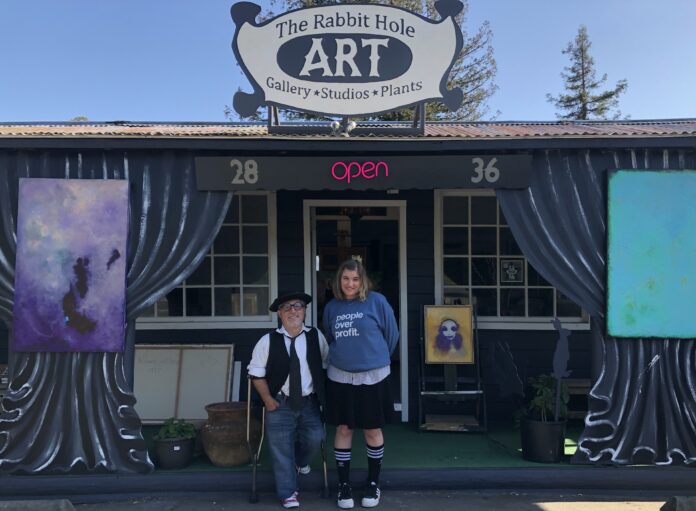New gallery’s May Day show focused on labor’s role in society
The founders of Sebastopol’s new Rabbit Hole Art Gallery and Studios displayed work exploring comfort and conflict in an art show earlier this month.
On Sunday, May 1, friends and visitors strolled into the Gravenstein Highway studio to browse and buy from the assembly of drawings, paintings and digital collages by Occidental-based artists Melissa Jones and Sam Roloff.
The art show is one of the first events hosted at the gallery since it opened in March this year.
Roloff founded the gallery in 2022, and together, he and Jones worked hard to remodel the place. Jones became the first artist to exhibit her work alongside Roloff’s in a show there.
“We’re pretty new, so we’re really just trying to get on the map in this area,” Roloff said of the “diamond in the rough” gallery. He shared that they intentionally lowered the price of their art on May 1 so it would be more affordable.
The date happens to commemorate both ancient European festivals surrounding the start of summer and International Workers’ Day. Though the show wasn’t advertised as such, multiple pieces offered commentary on labor issues in the distinct styles of the two artists.
Jones teaches art at Windsor High School and makes folk art that speaks to the struggle of grounding oneself in the richness of ordinary life in the midst of a demanding and chaotic capitalist society.
She painted a maypole dance that mingled the meanings of both holidays—the change of season and the celebration of workers. The piece depicts people twisting through the air around a maypole alongside messages like, “WORK,” “SHOP NOW” and “PAY UP.” At the base of the pole stands a girl with a sign reading, “STRIKE FOR CLIMATE.”
As a worker herself, Jones said the everyday rush of hyper-productivity and consumerism keeps people from slowing down to address other major issues at hand. “We gotta change the shit we’re doing, but we’re totally swirling in survival,” she said.
Other pieces of her art explore the working class life, motherhood, feminism and the value of domestic labor and other tasks traditionally considered “women’s work.”
“About 10 years ago, I started doing drawing as a meditative practice and trying to come to peace with my life as an ordinary life, as a schoolteacher and a mother, and kind of learning how to let my ego rest, and the struggle with the ego of that,” she said. “I would just pull from my ordinary life experience, and the drawings are really simple and oftentimes they don’t have a lot of layers and depth. But I’m just looking at one thing and saying, ‘This. This. Is what I’m looking at today.’”
Several digital collages and paintings by Roloff, a full-time artist and the brother to Matthew Roloff of the reality tv show Little People, Big World, explored the power dynamics and conflicts present in the modern world.
Roloff’s art often emphasizes the power of ordinary people uniting as a collective against institutional forces.
In one such piece, a battle unfolds near a European-style cafe. Police fight with a group of protesters dressed in yellow vests emblematic of the French working class protest movement, and ordinary people appearing as sheep and ballerinas—compliant in the eyes of the government, but beautiful in their movement.
“It looks like an army, and it demonstrates that the people have more power than they think because the photos don’t lie,” he commented.
Roloff said that because the mainstream media does not tell the story of organized labor in full, “there is a certain amount of responsibility for the artist to kind of help elevate things and bring them into people’s living rooms, if you will.”
He noted that while many countries celebrate the international labor movement on May Day, the U.S. holds its Labor Day holiday in September, “and it pretty much just turned into a barbecue weekend.” Roloff called this an effective, movement-stifling way of removing the context of the holiday.
Jones and Roloff share a disinterest in creating another gallery defined by exclusivity and big-budget art. They priced their works between about $50 and $1,500, save for a piece going for around $2,000 at the most, Roloff said.
“I’m a strong believer that if somebody wants my art, I want them to have it. I don’t want them to feel like, ‘Ooh, I can’t have it.’ It’s complicated because you don’t want to undervalue your work and have people think you’re undervaluing your work,” Jones said.
Plenty of visitors who stopped by on May 1 were artists themselves. Kristen Tucker of Santa Rosa purchased a limited series print from Roloff about Occidental.
“[It was] really cool and kind of spoke to the craziness of Occidental and the randomness that you’ll find there,” Tucker said, adding that the piece had a remarkably modest price tag.
“I couldn’t believe it,” she said. “The one piece I was looking at was like $400… Typically, a piece like that you’d see for like $1,400… So it’s nice to have an affordable and accessible artist that just wants to be part of the community.”
Mark Grieve, a Marin County artist, said when he looks at Roloff’s digital art, “I kind of feel like I’m watching a surreal version of the news.”
He described Jones’ art as raw and bold, with “wonderful honesty about her work that you can see in the way she uses her color.”
To see more of Jones’ work, follow @jones.drawings on Instagram. Roloff said his paintings will be in the upcoming season of Little People, Big World on TLC, coming out this month.
The Rabbit Hole Art Gallery is open most days from 11am to 7pm.. Those planning to visit can take their chances on Gravenstein Highway South in Sebastopol or call ahead at (503) 975-5256 to make an appointment.











